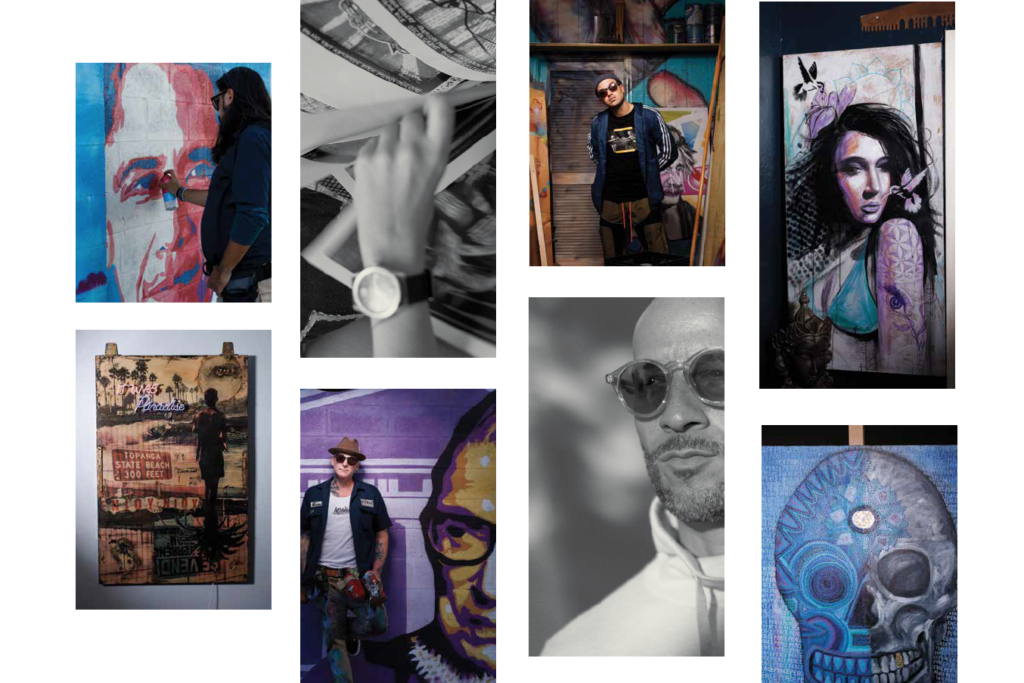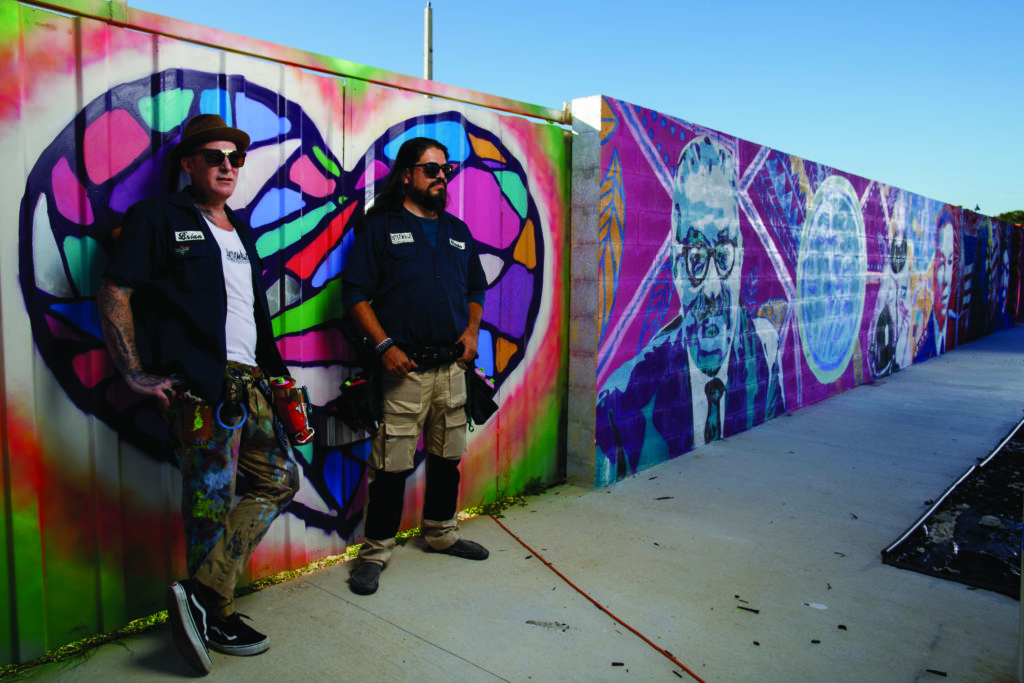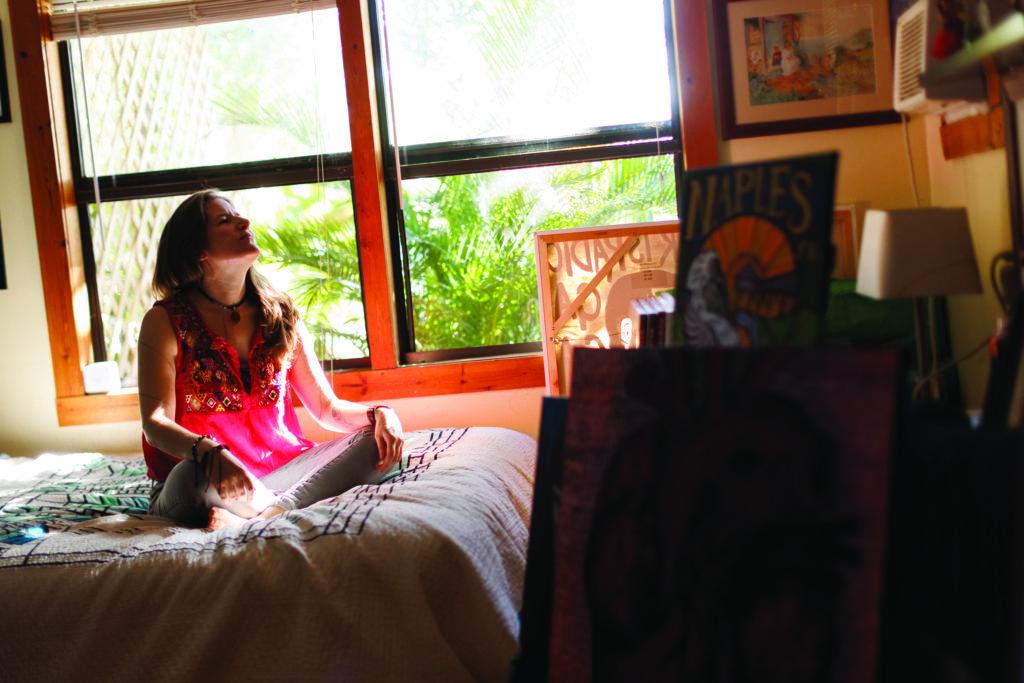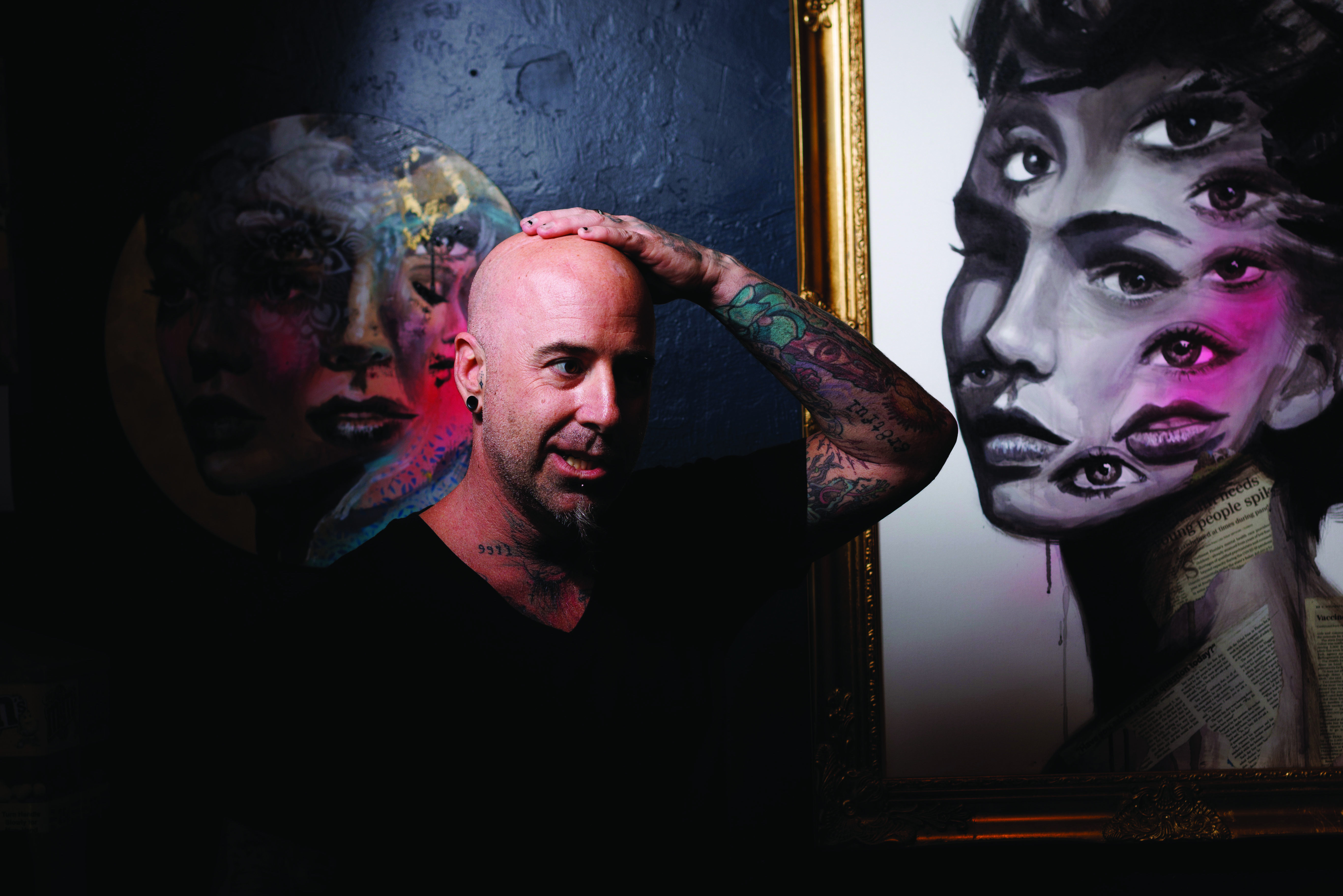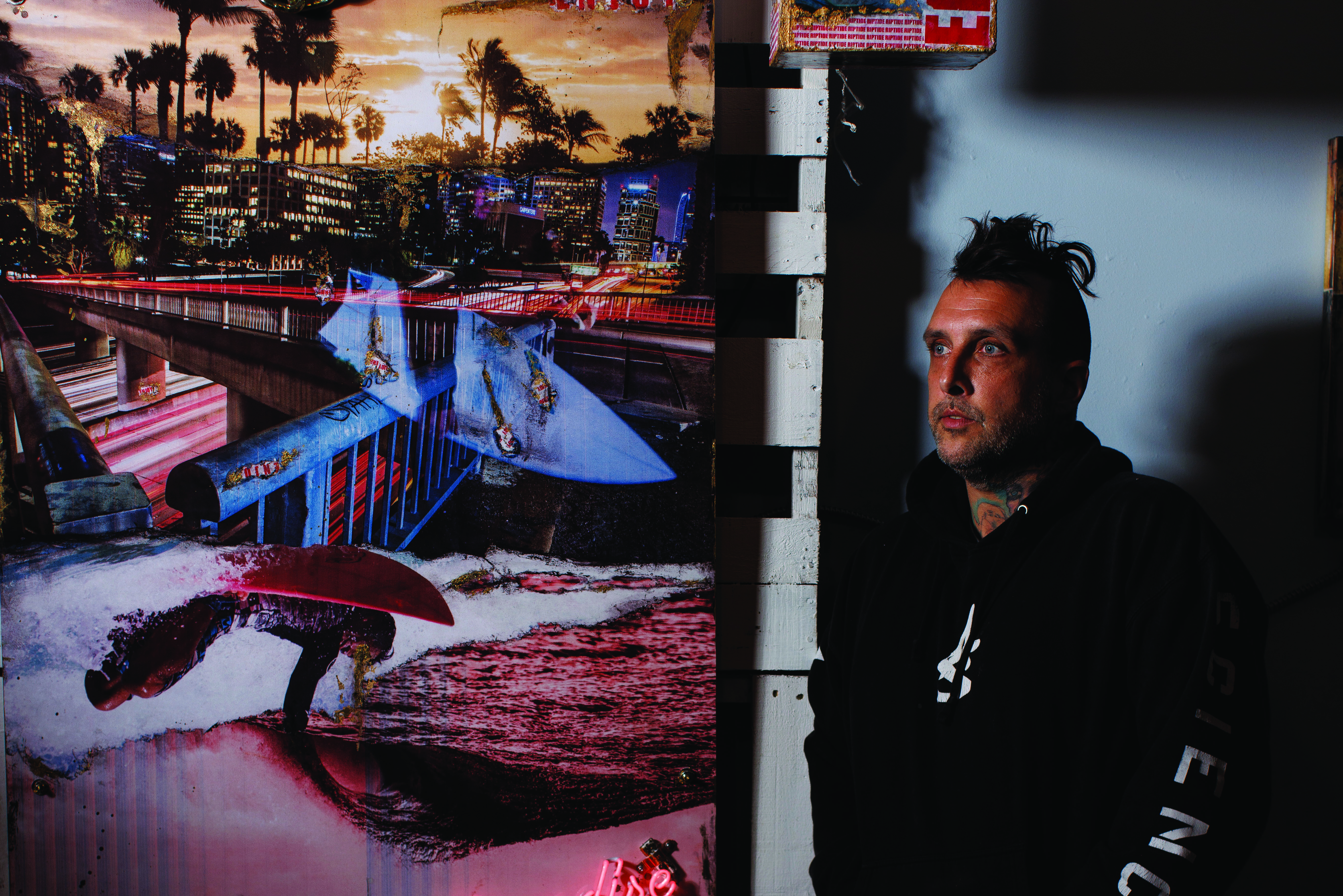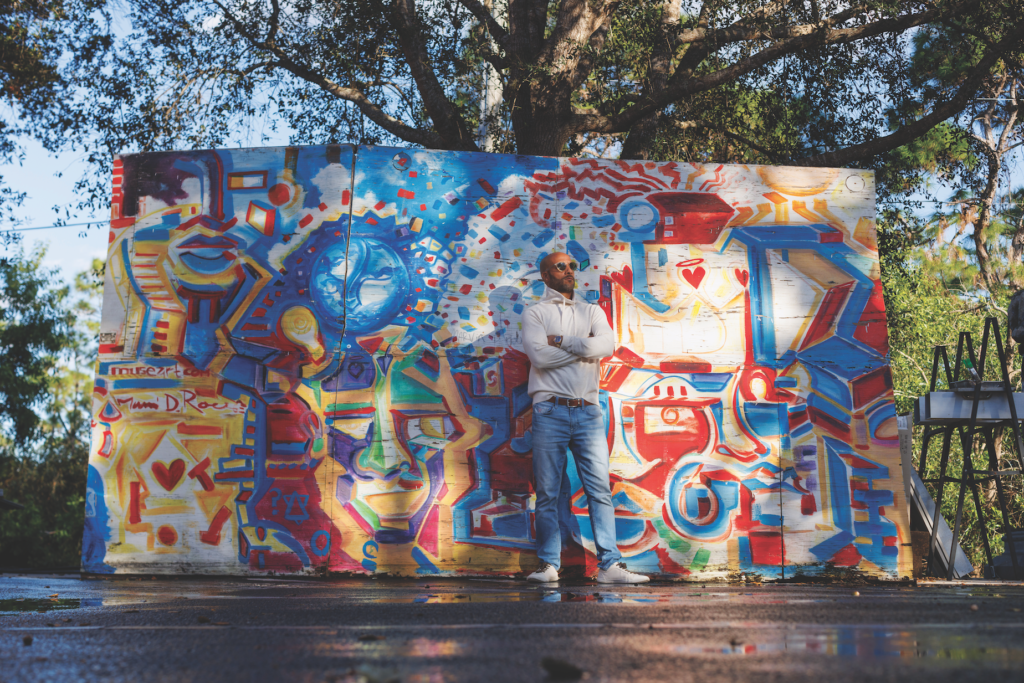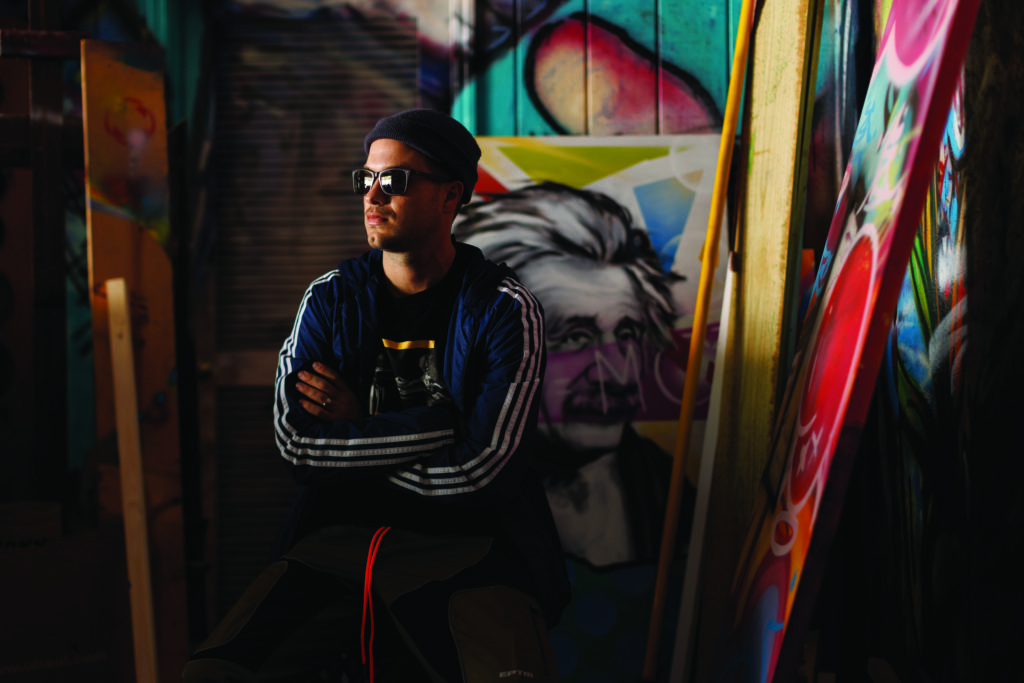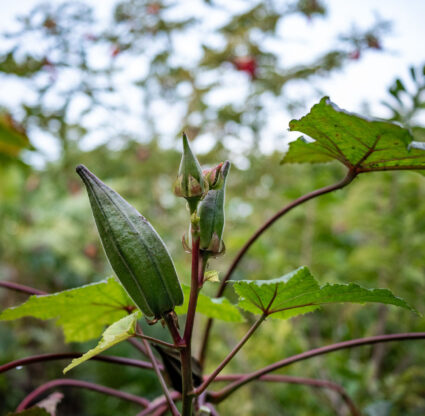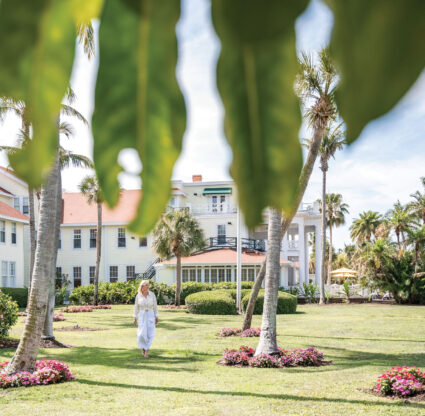Last summer, Sidney & Berne Davis Art Center curator Cesar Aguilera put together the Three M’s Synergy exhibit. In it, Marcus Zotter, Marvin Rouse and Matt “Mully” Mulhern’s graphic, pop culture-driven paintings spread across the 8,000-square-foot first-floor gallery. Upstairs, Cath Branwood’s You, Me, Them series showcased digital portraits, introspective black-and-white paintings and colorful homages to pop icons. Meanwhile, in the new Sidney’s Rooftop Sculpture Garden, visitors clustered around Fort Myers-inspired murals by Aguilera and Brian Weaver. The show represented a physical manifestation of the shift taking place in the local art scene, fueled by a collective of young artists with urban and rock ‘n’ roll sensibilities. These artists follow in the footsteps of revolutionists who proved the value of urban art at an international level over the past four decades. Consider street art and Neoexpressionist pioneer Keith Haring (whose work is currently on display at Naples Art) and Brooklyn-born painter Jean-Michel Basquiat in 1980s New York, and modern-day tagger Banksy (his Girl with Balloon, originally stenciled on a wall in East London, famously sold at a Sotheby’s auction for $1.37 million in 2018 before the artist shredded it on the spot; the partially shredded piece sold again last year for nearly 20 times the price).
But only in the past few years did locals start to take serious note. Acclaimed, Fort Myers street artist Marcus Jansen, who also has a studio in the Bronx, was among the first to exhibit urban works here, with his socially and politically motivated paintings in the early 2000s. It’s telling that the first major show by a local artist at Artis-Naples, The Baker Museum was Jansen’s solo show, exhibiting the artist’s expressive brushwork, stenciling and spray paint-filled canvases that speak of war, border walls and rising waters. Jansen goes on to credit Aguilera as the driving force behind the urban revolution in the local arts scene. At Artsemble Underground, the Fort Myers gallery Aguilera co-owns with graffiti artist Brian Weaver, he propels emerging and midcareer talent who break away from the traditional beach scenes and ocean-inspired abstracts that have long filled local galleries.
Though the expanding scene credits several contemporary pioneers, like Juan Diaz and David Acevedo, there’s a core group that satellites around Aguilera today with a similar vision. They’re often seen together: painting for the crowds at local events, collaborating on murals and supporting one another at openings. These artists present gritty, artistic commentary on social issues and pop culture, and actively push for more inclusion, as the region’s growing population brings an elevated appetite for diverse takes on culture. This close-knit crew’s works are not confined to traditional gallery spaces; instead, they live throughout the community: fine art-trained Zotter’s murals helped drive the evolution of Naples’ Bayshore Arts District; Mulhern’s painterly tattoos decorate people’s bodies; and Cory Patterson’s new The Think Box gallery operates in a shared professional workspace.
Here, we talk with the seven underground artists who are breaking the mold, shattering stereotypes and bringing light to dark spaces.
The Activists
At the heart of the movement, Brian Weaver and Cesar Aguilera use street art to encourage dialogue.
At Fort Myers’ Artsemble Underground, Brian Weaver and Cesar Aguilera are driven by a singular mission: to better the community through art. Inside, a mix of politically and punk rock-inspired works fill the space: Mulhern’s tatted Frida Kahlo rests above Weaver’s Banksy-inspired painting, depicting a young girl petting a huge bear; Branwood’s #BlackLivesMatter poster featuring Martin Luther King Jr. hangs with Aguilera’s Crown-of-Thorns-adorned John F. Kennedy. Everything about the gallery—from the represented artists, who previously struggled to find exhibition space, to the paint-splattered vintage sofas—is meant to be approachable. “A lot of people are scared to walk into a gallery,” Weaver says. “We want people to come in and really have a conversation about the art.”
Making art accessible has motivated Aguilera since he moved to the area more than 20 years ago from his native Ecuador. For Weaver—who was born in Panama and lived all around the United States with his “hippie” parents—graffiti serves as a platform to advocate for issues that keep him up at night: racism, animal cruelty and the lack of arts education in public schools. “There’s something about a can of spray paint, and just losing yourself in that wall, with the can, that releases pain as fast as you want it,” he says.
After meeting at Weaver’s former Fort Myers artist hub, Epicenter, in 2014, the two combined forces to create Artsemble Underground, which opened a gallery last year at Bell Tower Shops. To carry their ethos into the streets, they’re in talks with the city to decorate local structures with murals and to create new bus routes that would double as tours of the city’s public art. They’ve proposed a three-year plan to beautify Cape Coral and are working on a petition to remove the Civil War-era connotations tied to the county’s moniker by transitioning from Robert E. Lee County to Bruce Lee County, named after the famous martial artist, actor and philosopher. “Nothing would change: driver’s licenses, you know?” Weaver says—with only the slightest bit of humor. “We’re just rebranding Lee County, to not be [named around] a slave master.” The pair also work closely with local schools and nonprofits, like the I Will Mentorship Foundation, to show young artists how to make a living.
The duo’s aim is to use art to enact change. And their come-as-you-are gallery is the first step. “In a gallery or a museum, some people feel incompetent, they think they need a degree to understand the works,” Aguilera says. “But when it’s in the street, everyone can have an opinion and they’re okay talking about it.”
The Wanderer
Cath Branwood draws from a lifetime spent around the globe to connect with others through her art.
Cath Branwood is constantly swapping art with her talented friends. “I’ve got Marcus Zotter’s there,” she says, pointing to one of Zotter’s Sticker Art pieces, which shows a mugshot of a young Frank Sinatra drawn on a wood panel covered in blue stickers from skater brands and ’90s cartoons. In return, Zotter took Branwood’s trippy Willy Wonka painting. She gestures to another work nearby: Aguilera’s charcoal on coffee-stained paper Amy Winehouse portrait. “Cesar is a real champion of confidence, and he wants to support each of us,” she says.
The former lawyer, who moved to Naples in 2017, found her niche as a full-time artist after the pandemic hit when she started meeting like-minded creatives through social media and at events like those at Live Art Naples. Her loud, message-driven works—digital sketches of peers and famous people who inspire her, like Aguilera, (You); stark, moody black-and-white self-portraits (Me); paintings of icons surrounded by their empowering words (Them)—stray from the region’s traditional muted abstracts and beach scenes. “To have this town evolve, you’ve got to have artists that go with it,” Branwood says. “And this group of artists is screaming out: ‘We want to create more than just boats and palm trees.’”
Her work shows influences from a life spent around the globe: graffiti elements, inspired by the street art she was first exposed to as an exchange student in Atlanta; bold colors that nod to Mexico, where she spent four years as a scuba instructor and underwater photographer; and musical themes from her British Invasion-fueled upbringing in Birmingham, England. “I get inspired by you, by myself, by everything around me,” she says. That includes fellow female artists, like Naples’ Maria Collier, who she bonds with over classic rock and its influence on their work, and Fort Myers’ fashion designer and artist Mariapia Malerba. Last year, Branwood was invited to join the board of Fort Myers’ Love Your Rebellion, a female-run nonprofit that advocates for marginalized communities through arts events and self-published magazines.
Writing is another creative outlet for Branwood, who shares free verse poetry on her site, Artful Alternatives. Mulhern recently inked a tattoo that merges her passions: a single thread loops from one wrist, around her arm, across her back and down the other arm, connecting a quill and a paintbrush on either wrist. “I’m a writer and I’m an artist; it’s all part of one thread,” she says.
The Innovator
Matt “Mully” Mulhern flips the script on tattoo art with painterly designs.
Every client that walks through Independent Tattoo Company in Fort Myers leaves with one of Matt “Mully” Mulhern’s inked masterpieces. He’s one of the region’s most recognizable tattoo artists thanks to his colorful watercolor designs that look like they were done with a brush rather than a tattoo gun. On slow days at the shop, he’ll bust out a canvas, paint and let his imagination run wild. Now, after nearly 20 years, his paintings of famous musicians and contorted female faces are on display in kava bars and pizza joints throughout the community.
Though the Massachusetts native was always drawn to tattooing, having inked his first stick-and-poke (a shamrock on his thigh) at 14, he previously carved out an unfulfilling career at an investment company. On their first wedding anniversary, his wife helped him buy professional tattoo equipment to practice. “I gave her a shitty tattoo,” he jokes. Now, his tattoos commonly feature sinuous linework (think kaleidoscopic mandala designs), accented with splashes of watercolor that lend an ethereal air. And unlike a canvas, his work isn’t restricted to galleries. With each client, there’s a new audience.
Mulhern doesn’t restrict himself to just tattoo art—he also dabbles in painting, photography and wood-burning art. Despite the many opinions and revelations that his fans have pointed out, he doesn’t seek a deeper meaning, either. (Once, a viewer of a photo-inspired collage piece of his son standing near a “No Trespassing” sign questioned the “look in the boy’s eyes.” Mulhern laughs: “The look is, ‘Are you done taking photos, yet?’”) He focuses on creating from a technical standpoint, drawing inspiration from inverted photos; using maps and newspapers to add texture; incorporating his tattoo stencils; and mapping out images in Photoshop for his next painting or tattoo.
When he moved to Naples in 2003, he thought his style, which gravitates toward the gritty, boundary-pushing works of his street art peers, was out of place. But, a few years later, he met Cory Patterson, who was displaying his surfer and skater photography and abstract paintings at Sweet Art Gallery in the Naples Art District. This encouraged Mulhern to get into the scene, and the two have since become close friends. “Down here, all of my friends are artists, musicians or creatives,” he says. “Sometimes I wonder, if I didn’t move here, would I still be an artist?”
The Thinker
At his new gallery, Cory Patterson introduces Naples to the neon-tinged, message-filled voices of the underground.
Cory Patterson, who operates photography and art business Ten to Two (a nod to the time of day photographers typically avoid due to harsh light and shadows—and to his propensity for breaking such rules), recently unveiled The Think Box, a gallery within Naples’ Collier Capital Club shared workspace. Inside, Patterson spotlights a mix of artists from around the country, like his business and creative partner, Ohio-based neon artist Korey Sherer, and locals including Zotter and Mulhern. “We aren’t just a bunch of street artist-thugs running around,” he says. “I’ve got some heavy-hitters in my pocket.”
The tatted gallerist is working to break stereotypes associated with underground and street artists. And while Patterson’s art nods to the streets of places he’s lived and visited, with photography of local street signs and landmarks, he doesn’t attach labels to his style. Born and raised in Michigan, he discovered photography in high school, before moving to Naples with his parents in the early 2000s, when he began exploring the local art scene. His first show, at Sweet Art Gallery, was a pivotal moment for the burgeoning creative. There, he met Mulhern, who advised him to combine his abstract work and photography. Shortly after, Patterson moved to Los Angeles, where he spent about 12 years honing his art. “Living in L.A., near Silver Lake and the art district downtown, you would walk out and there’d be new art every day,” he says.
While California culture meshed with Patterson’s punk-rock surfer vibes, he missed the close-knit, laid-back feeling in Naples. When the pandemic created heavy restrictions in California, he decided to move back. Now, at The Think Box, he hosts shows like last month’s Ahhh s!$@ another BBQ group exhibition, featuring work from Naples’ street artist Nick Rapp (who, like Zotter, is beautifying Bayshore with murals), Canadian color-theory artist Ramona Nordal and other out-of-town creatives. The mix of local and national artists, he believes, draws a bigger audience. “That opens up an extended community of people that are now following me, following the artists,” he says.
The Dreamer
Marvin Rouse envisions Southwest Florida as a cultural hub that encourages creatives of all backgrounds.
Indianapolis-born Marvin Rouse has always been inspired by graffiti artists and their self-expression. “I was definitely into hip-hop culture. I was into the spray bombing, but I wasn’t into getting locked up and not getting paid for it,” he says. Instead, he channeled his creativity away from the streets and started creating puff-painted jackets and backdrops for local rap groups’ album art. A few gigs doing murals laid the groundwork for his career in Naples, where he’s made a name for himself painting live for charity auctions, at car shows and at fashion events.
His love of fast cars, fashion and hip-hop didn’t seem to gel in Naples, until he was introduced to longtime Naples Art District folks, like potter Jim Rice. “These guys are a really important part of the history,” he says. While Rice’s work doesn’t share the same street art influences, the potter built a culture of live art demonstrations and generated momentum for events like Naples Art’s Dinner With Artists and Legal Aid’s Art Aid Quick Draw. “With these nonprofits, people are being exposed to our work,” Rouse says, recounting a time when, during a live painting session, he created a typical beach scene to appease the crowd, only to be shocked that they flocked to his go-to faces that incorporate elements of graffiti and messages about spirituality and love. “[The area] needs something fresh,” he says.
As cultural interests diversify, Rouse sees Naples becoming a hub for a broader range of arts and culture. In 2014, he launched Studio 1084, a creative space where he stores his lifetime collection of paintings, sculptures and mixed media works, and often invites musicians and artists to drop by for private parties, during which they create together. To further his mission, he also encourages artistic youth through nonprofits, like Child’s Path. “For a long time, it looks like nothing is happening, just like a seed in the ground,” he says. “You just have to be willing to tend it and know what it can become, and then it becomes.”
The Tagger
Marcus Zotter draws from his fine art education to create pop culture-inspired murals that seem to jump off the walls.
Marcus Zotter grew up walking the streets of Philadelphia, surrounded by art in all forms: museums, classes at his alma mater Pennsylvania Academy of the Fine Arts (PAFA), neon spray-painted murals on the sides of abandoned buildings. But he never thought he could turn his gift for fine art and graffiti into a thriving career, especially in Southwest Florida: “It was a culture shock when I moved to this town, thinking I wasn’t going to fit in here.” After graduating from PAFA, Zotter moved to Naples, where he had family, with the intention of making his way to Miami. “When you graduate as an artist, you’ve got a few of the major cities where you can go: New York, L.A. and Miami—which is such a hotspot,” Zotter says. “When I moved down here, I realized that Naples was actually looking for the vibe that I was ready to bring.”
The youngest in this creative crew, Zotter looks to Mulhern and the other artists as he shapes his artistic identity. “I love describing Mully to people down here,” he says. “He’s a skulls-and-roses kind of guy, kind of rough-edge. He’s one of the most prolific tattoo artists here; I see his tattoos all over the town. And he sells a ton of artwork off the walls.” Zotter’s creations, whether it’s a polar bear triptych or a mural of Ruth Bader Ginsburg, show his fine art training through hand-drawn details and realistic shading, and always leans toward street art with bold colors, pop culture elements and his instantly recognizable tag (the artist’s stylized signature).
Though he’s received some pushback from naysayers who thought Naples wasn’t a fit for his Philly-inspired works, which often feature neon spray paint and graphic characters, he’s become the town’s go-to graffiti artist, painting murals at popular restaurants, like LowBrow and Cosmic Kava, and in private homes, where his style adds color to kids’ rooms, guest baths and pool decks. In 2017, jeweler Amanda Jaron commissioned Zotter to paint a floral mural on the side of her shop in the Bayshore Arts District—a move that many credit as a catalyst and which still stands as an emblem for the now-bustling neighborhood. “Because of this town, I am an artist,” Zotter says.

